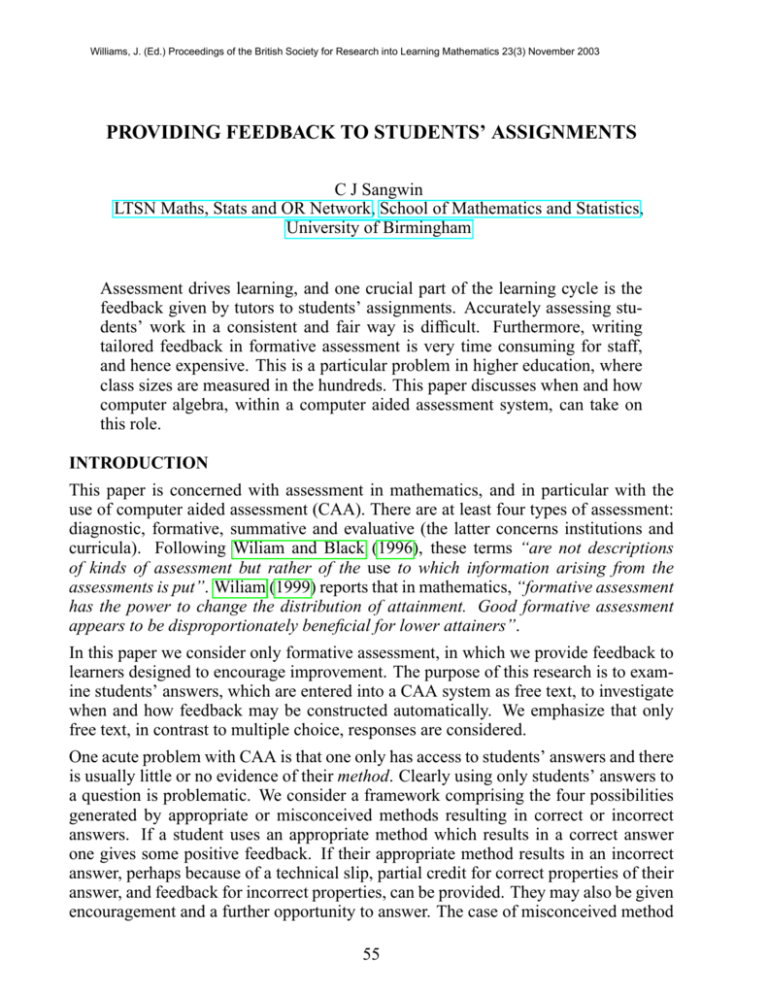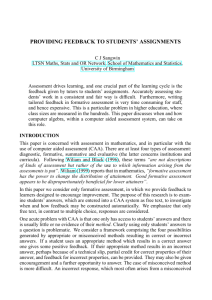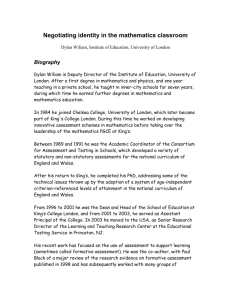providing feedback to students` assignments
advertisement

Williams, J. (Ed.) Proceedings of the British Society for Research into Learning Mathematics 23(3) November 2003
PROVIDING FEEDBACK TO STUDENTS’ ASSIGNMENTS
C J Sangwin
LTSN Maths, Stats and OR Network, School of Mathematics and Statistics,
University of Birmingham
Assessment drives learning, and one crucial part of the learning cycle is the
feedback given by tutors to students’ assignments. Accurately assessing students’ work in a consistent and fair way is difficult. Furthermore, writing
tailored feedback in formative assessment is very time consuming for staff,
and hence expensive. This is a particular problem in higher education, where
class sizes are measured in the hundreds. This paper discusses when and how
computer algebra, within a computer aided assessment system, can take on
this role.
INTRODUCTION
This paper is concerned with assessment in mathematics, and in particular with the
use of computer aided assessment (CAA). There are at least four types of assessment:
diagnostic, formative, summative and evaluative (the latter concerns institutions and
curricula). Following Wiliam and Black (1996), these terms “are not descriptions
of kinds of assessment but rather of the use to which information arising from the
assessments is put”. Wiliam (1999) reports that in mathematics, “formative assessment
has the power to change the distribution of attainment. Good formative assessment
appears to be disproportionately beneficial for lower attainers”.
In this paper we consider only formative assessment, in which we provide feedback to
learners designed to encourage improvement. The purpose of this research is to examine students’ answers, which are entered into a CAA system as free text, to investigate
when and how feedback may be constructed automatically. We emphasize that only
free text, in contrast to multiple choice, responses are considered.
One acute problem with CAA is that one only has access to students’ answers and there
is usually little or no evidence of their method. Clearly using only students’ answers to
a question is problematic. We consider a framework comprising the four possibilities
generated by appropriate or misconceived methods resulting in correct or incorrect
answers. If a student uses an appropriate method which results in a correct answer
one gives some positive feedback. If their appropriate method results in an incorrect
answer, perhaps because of a technical slip, partial credit for correct properties of their
answer, and feedback for incorrect properties, can be provided. They may also be given
encouragement and a further opportunity to answer. The case of misconceived method
55
Williams, J. (Ed.) Proceedings of the British Society for Research into Learning Mathematics 23(3) November 2003
is more difficult. An incorrect response, which most often arises from a misconceived
method, can attract identical partial credit for correct properties of their answer, and
feedback for incorrect properties. Without intervention and support it is doubtful if
encouragement and a further opportunity to answer will significantly help the student,
unless method hints are included in the feedback. Perhaps the most worrying case is
when a misconceived method results in a correct answer. If we only base the response
on this answer we must award full credit. The misconception is then left to fester
dangerously, with the student having been rewarded.
Although this study takes place in higher education, the data presented below is taken
from the beginning of a first year core calculus and algebra course. Hence, the material
would not be out of place in A-level pure mathematics. This material was chosen so
that the research might be applicable to the broadest range of mathematics educators.
METHOD
The CAA system used in this study is known as AIM, and is based on the computer
algebra package Maple. Answers are entered as free text using a simple syntax, which
are then tested objectively using computer algebra. The system tests the student’s answer to check it has the required properties, rather than to see if it is the answer. In
particular, AIM correctly assesses different algebraic forms of an answer. The system
is also capable of giving partial credit and feedback. Another feature of this system is
that in a multi-part question, should a student get the first part incorrect, the system can
perform follow-on marking necessary to award credit for the subsequent parts. Designing such marking schemes is problematic, although this issue will not be address here.
Students may also rectify their mistakes and repeatedly attempt any particular question,
accruing a small penalty for each such incorrect response. Limited space precludes including screen shots of the working system. More details of using computer algebra
based computer aided assessment can be found elsewhere, such as Strickland (2002);
Sangwin (2003).
The study took place at the University of Birmingham over two years, where AIM is
used routinely in the first year core calculus and algebra course, for diagnostic, formative and summative assessments. Formative assessments are set weekly to approximately 190 students, each comprising 10–20 questions. For each student, the system
generates questions randomly, marks the work, and provides feedback to the student.
Data is presented only for three questions, although we have similar data for each question we set using the CAA system described. To be concrete about methodology, let us
consider our first question:
Z
p
(1)
Find
x q dx.
For each student two random integers were generated satisfying
p ∈ {3, 5, 7, 11, 13} and q ∈ {2, · · · , 12}
with the extra condition that if p = q , then use q + 1 instead. The system tracks
which random numbers have been assigned to each student and marks their responses
accordingly. Data for this question will be presented in the results section below.
56
Williams, J. (Ed.) Proceedings of the British Society for Research into Learning Mathematics 23(3) November 2003
We believe that using such randomly generated questions reduces the problem of plagiarism, but more importantly for research purposes it allows one to check for any bias
introduced to the data by particular choices of numerical values. In this case, the absence of a constant of integration was ignored, although being strict in requiring one is
a possibility.
The system itself collates and presents the data, both aggregate data about individual
questions, and the responses of individual students. The system groups data according
to the values of p and q used. A typical response for one pair (p, q) = (13, 10) being
QuestionNote = "Int(xˆ(13/10),x) = 10/23*xˆ(23/10)"
Answer = "10/13*xˆ(13/10)" x 1
Answer = "10/13*xˆ(23/10)" x 2
The QuestionNote gives information about which random numbers have been used
in the form of the problem and the correct solution. The Answer = displays the answers given to this version of the question, together with the number of such responses,
(ie x 2). In this case the system has been instructed to summarize only answers which
did not get full marks.
Qualitative data pertaining to a student’s method for answering a particular question
is gathered using online surveys which take place immediately after a student has answered such a question. Experience of using interviews, paper based questionnaires
and such online feedback suggests that the immediacy of the online format gives both
reliable and rich data. Students also seem more willing to express themselves online
than they do in writing. Interviews are time consuming, whereas the online form allows each student to be surveyed and automatically matches their responses with their
question. Hence, the survey is not strictly anonymous since the researcher can match
comments with particular answers – which is obviously advantageous. Once the test is
complete the data is examined to identify patterns of incorrect responses, and methods.
This is presented below.
RESULTS
Indefinite integration
The responses to this problem are taken from the 2003 cohort of 190 students. Each
student was asked this question only once, and we consider only their first attempts,
although repeat attempts are possible and encouraged. Some 34% of students made
an error on their first attempt, and by examining these the mistakes shown below were
identified.
1 n−1
nx
n−1
nx
1
1 n
nx
n
0 nx
1
1 n+1
nx
n+1
1 nx
17
2
(n + 1)xn−1 0 (n + 1)xn 2 (n + 1)xn+1 16
1
n−1
n−1 x
1
1
n
n+1 x
4
1
n+1
n+1 x
57
na
Other
19
Syntax error 16
Williams, J. (Ed.) Proceedings of the British Society for Research into Learning Mathematics 23(3) November 2003
Forms and frequencies of students’ incorrect answers.
By syntax error we mean results which are syntactically correct but
are not what
R which
9
5
the student probably meant. For example, a student’s answer to x 4 dx(= 49 x 4 ) was
4/9*xˆ9/4 = 94 x9 41 = 19 x9 . While this is incorrect, we know what the student meant.
The other errors do not fit the above categories,
most of these could have been
R 5 although
7
6
the answer to an integration problem, eg x 6 dx = 7 x 6 .
It is straight forward to test for each of these errors, in an identical way to testing for the
correct answer, and provide feedback to suggest how to correct a mistake. However,
only three errors occur with a frequency which is
In addition to this, the
R significant.
5
7
CAA may operate on a particular answer such as x 6 dx evaluated erroneously as 76 x 6
in order to automatically generate feedback such as the following.
The derivative of your answer should be equal to the function that you were asked
5
7
to integrate, which was: x 6 . In fact, the derivative of your answer is x 6 so you must
have done something wrong.
Below are error rates at a first attempt to solve (1) for different values of p and q .
p 1 3 5 7 11 13
% 28 30 38 38 26 39
q 2 3 4 5 6 7 8 8 10 11 12
% 53 33 28 40 46 60 38 22 44 18 6
Considering only p, we see no significant differences between values. However, different values of q have a marked effect on students error rates. Interestingly, there was
no significant differences between p < q (proper fraction) and p > q (vulgar fraction),
which might have been expected.
Quadratic equations
In this section we present results from the following two part question.
(i) Give an example of a quadratic, with roots at x = p and x = q .
(ii) What is the gradient at p+q
2 ?
In this question the numbers p and q were randomly chosen for each student so that
p ∈ {1, 2, 3}, r ∈ {1, 2, 3} and q := p + 2r. Thus p + q is even, and so the number
given in part (ii) is an integer. Note, there is a family α(x−p)(x−q) of correct answers,
for all α 6= 0, and regardless of which α is chosen the answer to the second part is 0.
This question was carefully designed so that it was possible to answer the second part
correctly, without answering the first part. The students were asked in an attached
questionnaire to explain briefly their method in answering these linked questions.
Of the 177 responses to this question, 80% were correct on the first try and a further
14% were correct on the second attempt. Only 2% of students did not correctly answer
part (i) eventually. Similarly, of the 174 responses to part (ii), 71% were correct on the
58
Williams, J. (Ed.) Proceedings of the British Society for Research into Learning Mathematics 23(3) November 2003
first attempt, with a further 13% correct on the second. However, 6% of students made
10 incorrect attempts or failed to correctly answer the question.
What is more interesting are the results of the feedback questionnaire. For the first
part the vast majority of the students’ concept of a quadratic is an expression in the
unfactored form. The following is a typical student response.
If the roots are a and b you multiply out y = (x − a)(x − b) to get the quadratic y .
However none of the students demonstrated knowledge that the factored form was
equally acceptable, required less calculation, and gave fewer opportunities for error.
The feedback for the second part was more revealing. Encouragingly, 86% of students
“differentiated and then subs in the given x value”, which is is one very obvious strategy. Some 3% of the students misread the question and “Used differentiation and put
this equal to zero to find the turning points”. Similarly, 3% used geometrical thinking
and described their method as “5 is the mid-point of the two roots, 2 and 8, therefore
parabola is at minimum. Gradient must be 0”. What the feedback questions also revealed, were a number of misconceptions. Some of these were only mild, and would
be ideal starting points for formative feedback, such as
roots at 2 an 4, its common sense that the curve would haveto make a veryu sharp
turn between these two, an the obvious place for this turn would be exactly between
the two points so 3. Now gradient at a turning point is always zero!
Other responses revealed much more serious misconceptions which nevertheless resulted in the correct answer: 6% of students responded that “x = 2 is a vertical line so
its gradient was zero”. This is an example of a correct answer derived from a misconceived method which examining the answer alone will never reveal.
Odd and even functions
Students were asked to give three different examples of odd functions, which the computer algebra evaluated by comparing f (x) + f (−x) with zero. The data, which is
presented in Sangwin (2004), revealed that x3 was significantly more frequent than x,
and that f (x) = 0 was absent. This corroborates previous research such as Selden and
Selden (1992) which demonstrated that such singular (sometimes referred to as trivial
or degenerate) examples are often ignored by students. A more subtle feature of the
data is that the majority of the coefficients which are not equal to 1 are odd. It appears
that students are making everything odd, not simply the exponents, eg 3x5 , 5x7 were
typical responses. Students’ concept image (see Tall and Vinner (1981)) appears to
include only a subset of functions captured by the agreed concept definition. While not
incorrect, they posses a deficient concept image.
Feedback to address this misconception, which modifies the student’s answer and gives
some positive and hopefully thought provoking feedback, has been implemented. Essentially this adds one to each coefficient in a student’s answer, if a student provided
an odd function with odd coefficients all greater than one. The staff member may use
59
Williams, J. (Ed.) Proceedings of the British Society for Research into Learning Mathematics 23(3) November 2003
the system to automatically collate forms and frequencies of students’ responses and
present these together with additional interesting or important examples. This could be
used for class discussion to help integrate the CAA into a coherent learning cycle.
CONCLUSION
Examining only students’ answers reveals any bias introduced by particular choices of
random parameters. While this information may not be relevant for design of formative
assessment, demands for equity in summative assessment requires consideration of this.
In some cases, such as the question (1), it is possible to produce high quality tailored
feedback automatically which is based only on properties of answers and common mistakes. In other cases, a correct answer may obscure a serious misconception. Therefore, mechanisms which attempt to distinguish between appropriate and misconceived
methods need to be further developed, integrated into the CAA and deployed routinely.
Some styles of questions reveal deficient concept images, and where these can be identified positive feedback may be used to encourage students to consider other approaches
or aspects of the topic.
REFERENCES
Sangwin, C. J.: 2003, Assessing higher mathematical skills using computer algebra marking through AIM, Proceedings of the Engineering Mathematics and
Applications Conference (EMAC03, Sydney, Australia), pp. 229–234.
Sangwin, C. J.: 2004, Assessing mathematics automatically using computer algebra and the internet, Teaching Mathematics and its Applications 23(1), 1–14.
Selden, A. and Selden, J.: 1992, Research perspectives on concepts of functions,
in G. Harel and E. Dubinsky (eds), The concept of function, Vol. 25 of Mathematical Association of America Notes, Mathematical Association of America,
pp. 1–16.
Strickland, N.: 2002, Alice interactive mathematics, MSOR Connections 2(1), 27–
30. http://ltsn.mathstore.ac.uk/newsletter/feb2002/pdf/aim.pdf (viewed December
2002).
Tall, D. O. and Vinner, S.: 1981, Concept image and concept definition in mathematics, with special reference to limits and continuity, Educational Studies in
Mathematics 12, 151–169.
Wiliam, D.: 1999, Formative assessment in mathematics: (1) rich questioning,
Equals: Mathematics and Special Educational Needs 5(2), 15–18.
Wiliam, D. and Black, P. J.: 1996, Meanings and consequences: a basis for distinguishing formative and summative functions of assessment?, British Educational
Research Journal 22(5), 537–548.
60








